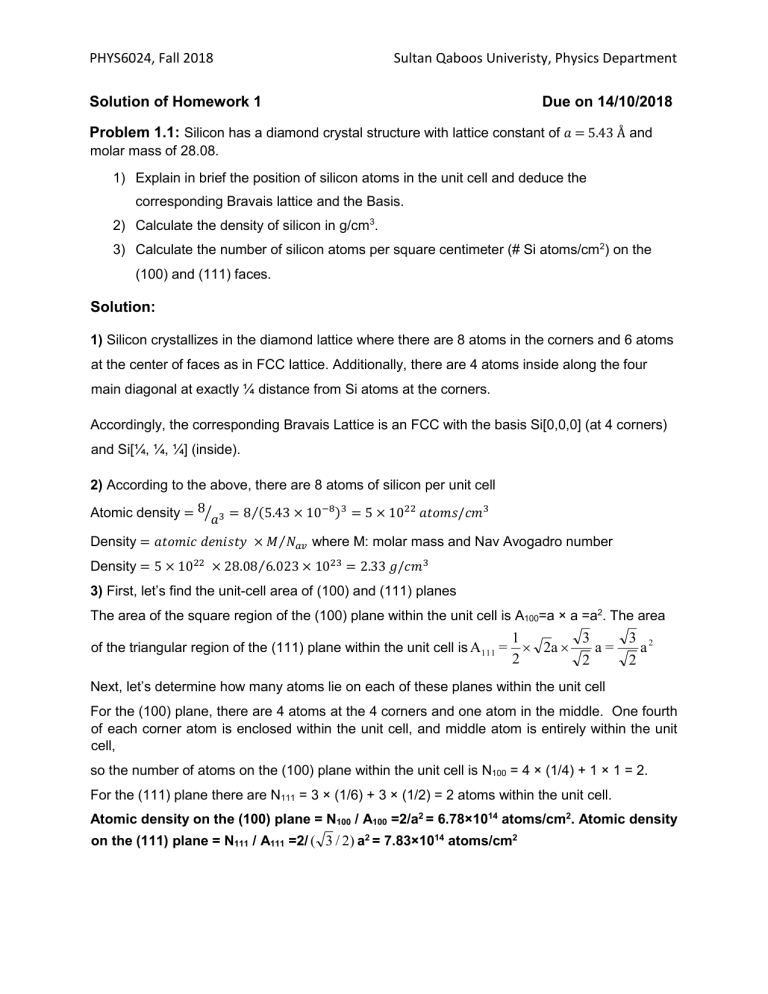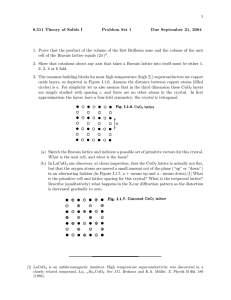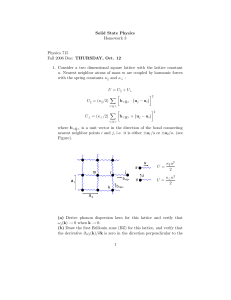Solution Homework 1
advertisement

PHYS6024, Fall 2018 Sultan Qaboos Univeristy, Physics Department Solution of Homework 1 Due on 14/10/2018 Problem 1.1: Silicon has a diamond crystal structure with lattice constant of 𝑎 = 5.43 Å and molar mass of 28.08. 1) Explain in brief the position of silicon atoms in the unit cell and deduce the corresponding Bravais lattice and the Basis. 2) Calculate the density of silicon in g/cm3. 3) Calculate the number of silicon atoms per square centimeter (# Si atoms/cm 2) on the (100) and (111) faces. Solution: 1) Silicon crystallizes in the diamond lattice where there are 8 atoms in the corners and 6 atoms at the center of faces as in FCC lattice. Additionally, there are 4 atoms inside along the four main diagonal at exactly ¼ distance from Si atoms at the corners. Accordingly, the corresponding Bravais Lattice is an FCC with the basis Si[0,0,0] (at 4 corners) and Si[¼, ¼, ¼] (inside). 2) According to the above, there are 8 atoms of silicon per unit cell Atomic density = 8⁄ 3 = 8⁄(5.43 × 10−8 )3 = 5 × 1022 𝑎𝑡𝑜𝑚𝑠/𝑐𝑚3 𝑎 Density = 𝑎𝑡𝑜𝑚𝑖𝑐 𝑑𝑒𝑛𝑖𝑠𝑡𝑦 × 𝑀⁄𝑁𝑎𝑣 where M: molar mass and Nav Avogadro number Density = 5 × 1022 × 28.08⁄6.023 × 1023 = 2.33 𝑔/𝑐𝑚3 3) First, let’s find the unit-cell area of (100) and (111) planes The area of the square region of the (100) plane within the unit cell is A100=a × a =a2. The area of the triangular region of the (111) plane within the unit cell is A111 = 1 3 2a a= 2 2 3 2 a 2 Next, let’s determine how many atoms lie on each of these planes within the unit cell For the (100) plane, there are 4 atoms at the 4 corners and one atom in the middle. One fourth of each corner atom is enclosed within the unit cell, and middle atom is entirely within the unit cell, so the number of atoms on the (100) plane within the unit cell is N100 = 4 × (1/4) + 1 × 1 = 2. For the (111) plane there are N111 = 3 × (1/6) + 3 × (1/2) = 2 atoms within the unit cell. Atomic density on the (100) plane = N100 / A100 =2/a2 = 6.78×1014 atoms/cm2. Atomic density on the (111) plane = N111 / A111 =2/ ( 3 / 2) a2 = 7.83×1014 atoms/cm2 Solution to Problem 1.2: Find the Miller indices for the following panes: a) 2a a 2a ½ 1 ½ (1 2 1) b) a a 0 1 1 (0 1 1) c) a/2 3a 2a 2 1/3 ½ (12 2 3) d) a -a a 1 -1 1 (1 1̅ 1) Solution to Problem 1.3: A cylindrical Si ingot is produced whose axis is oriented in the [001] direction. A flat is subsequently machined along the side of the cylinder forming a (110) plane as shown in Figure. A research program requires wafers whose surfaces are (112) planes. Indicate how the ingot must be sawed to achieve the desired wafers. Angle between (001) and (112) 𝑐𝑜𝑠𝛼 = 0×1+0 ×1+1 ×2 1 × √6 = 2 √6 ⇒ 𝛼 = 35.26° Angle between (110) and (112) 𝑐𝑜𝑠𝛽 = 1×1+1 ×1+0×2 1 × √6 = 2 √12 ⇒ 𝛽 = 54.74° Problem 1.4 Software learning “Using Crystal Viewer” Use crystal viewer available in nanohub under the link https://nanohub.org/tools/abacus you need to login first. Procedure Visualization of the three planes Visualization of their intersections Solution to Problem 1.5*: (2D Lattice) Consider the following 2D hexagonal lattice: a) Find the primitive lattice vector 𝒂⃗ 𝟏 and 𝒂⃗ 𝟐 b) Sketch in the same figure above the Wigner-Seitz primitive cell. Hint: it should have 6 facets. c) Find the reciprocal lattice vectors 𝒃⃗ Hint: you can either use the formula 𝒃⃗ for 𝟏 𝟏 and 𝒃⃗ 𝟐. 𝟐𝝅 𝜹𝒊𝒋 OR define 𝒂⃗ 𝟑= 𝒛̂ and use the equation 3D lattice. d) Plot carefully the reciprocal lattice points and the first Brillouin zone in k-space. By rotating the direct lattice by 90, we obtain the reciprocal lattice! (Adjust the scale): Also hexagonal




